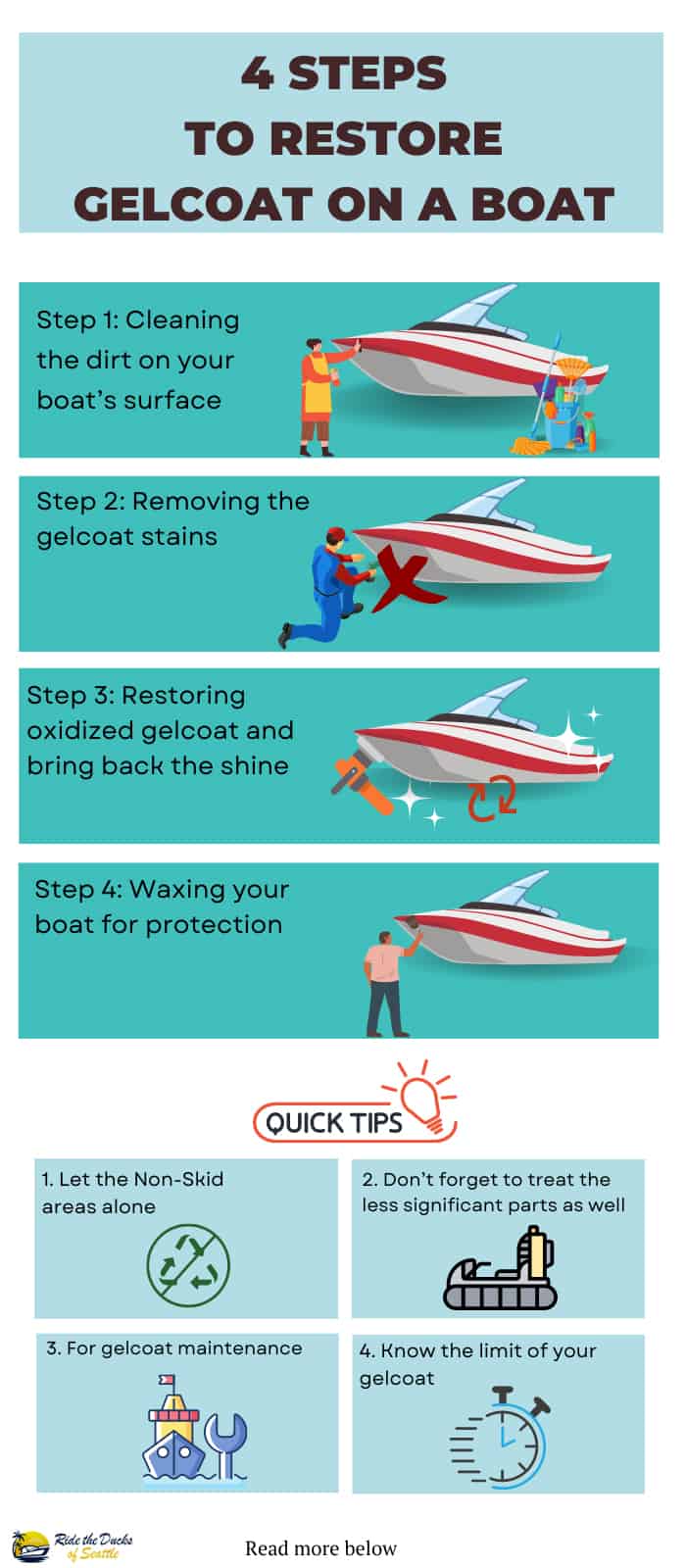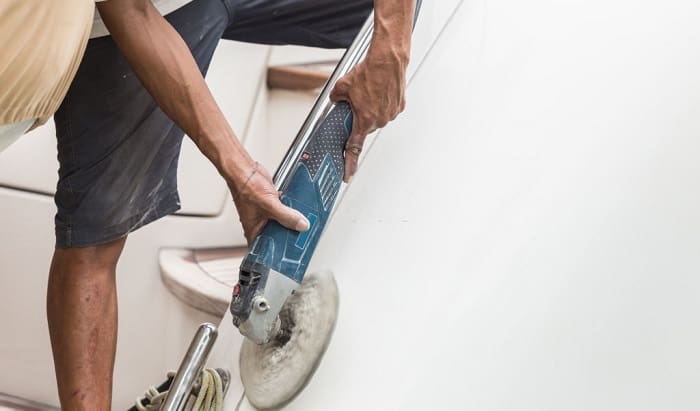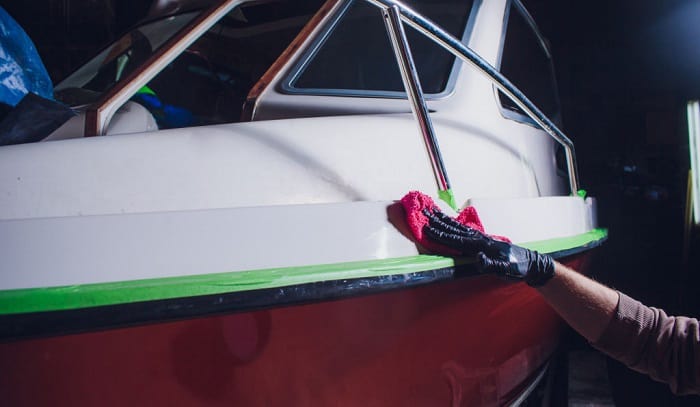For many boat owners, the first impression that pushes them to pick one boat over another is the shiny gel coat cover. Everyone wants their vessel to look gleamy all the time. However, due to the environmental impact, it is inevitable for our gelcoat to start wearing out.
Boat gelcoat restoration is an important part of the boat maintenance process. In this article, you will learn about the restoration process, which includes cleaning the dirt, removing the gelcoat, restoring oxidized gelcoat, and waxing for protection, as well as some other tips and tricks to maintain your gelcoat layer, improving its tenacity.
Follow this guide if you want to know how to restore gelcoat on a boat, and better yet, to be able to keep its condition for a longer time in the future.
Table of Contents
The Preparation Work
Before starting your gelcoat restoring process, please prepare these tools and supplies:
- Goggles
- Knee pads
- A medium or coarse brush
- A soft-bristle handheld brush
- A chamois
- A flexible tube with a nozzle
- Some cotton rags
- A bucket
- Some boat soap
- Fiberglass gelcoat restorers: Polish and wax materials
- Marine boat soaps, or at the minimum, the detergents that won’t remove your gel coat
Besides these must-have supplies, you can bring an orbital or circular polishing machine to make things easier. Remember that it must be GFCI-protected if it is an AC unit. Now, you are ready to restore your boat gel coat.
Step-by-Step Instructions
The restoration work is not too complicated or tiresome but can be extremely valuable in improving your boat’s look and longevity. Follow this step-by-step guide to make use of your boat gel coat restorer:
Step 1: Cleaning the dirt on your boat’s surface
Have an initial wash-down by mixing marine boat soap with water, then carefully clean every nook and cranny with a rag. I recommend going for the marine boat soaps because they are much better for the environment than the popular detergents and are residue-free when rinsing.
Occasionally, the non-skid areas in your boat will have mold, which is quite difficult to clean. For this matter, your best bet is to use the chelating non-skid cleaner. They are made for breaking the connection between your deck and all the dirt and mold without much scrubbing.
When the dirt is no longer there, it is time to check for damages to the boat surface. Carefully find any cracks around the stanchions and other crucial parts, as they might indicate some hidden structural issues.
Your quick guide to handling the cracks is to fill them with gel coat paste. Next, lightly rub the bulges with sandpaper until they are no longer there. Finally, clean the sanding residue with some acetone, and you can proceed to the next step.
Step 2: Removing the gelcoat stains
To some degree, gelcoat staining is inevitable on any boat after some time of use. There are deeper levels of stain that marine soap and water can not clean up. It is why we have to apply a more severe method.
Stains can be anywhere. In some cases, they cover the entire hull or topsides of a boat. There are mineral and organic stains. Mineral stains refer to the rust and black streaks caused by metals oxidizing. Organic stains are the discolorations that come from coffee, leaves, wine, or bird droppings.
Be it mineral or organic-origin discolorations, acid-based stain removers are always a reliable choice. You should pick the gel version as they are very easy to use and hold well to any surface (including vertical). Better yet, they require little to no scrubbing; the chemical reaction will do all the work.
Remember that acid-based stain removers are not recommended on varnish and galvanized surfaces, as they can corrode. You also need to protect yourself from the acid by wearing rubber gloves and eye protection.
In some places, air pollution can cause stains over the whole surface of a boat, to the point you can’t even notice the changes with naked eyes. Hence, after a while, try doing a quick check by applying some stain removers on a random area that looks fine otherwise.
After 20 minutes, rinse off the substance and re-check. If your boat’s color changes (typically getting brighter and more vibrant), you have a lot of work to do. Your vessel can return to its original color once you cover the entire hull and topside with stain removers.
If you are not into acid, consider other types of detergents for different types of stains. There are specific removers for molds, rust stains, black streaks, exhaust stains, and even droppings from birds and spiders. If you have finished, continue reading to know about the next step you need to take.
Step 3: Restoring oxidized gel-coat and bring back the shine
Oxidation can be a pain to many boat owners, as it creates a slight dull overlay on your boat’s Gelcoat, hindering the gleaming look. This phenomenon appears on any boat that is used for a decent time. To restore the oxidized gel coat, please follow these steps:
The first thing for you to do is select a Gelcoat restorer. You must understand the traits and differences between polishes and rubbing compounds (a much stronger type of polishing agent that uses abrasion to smoothen your Gelcoat surface).
You should use a rubbing compound only if the gel coat is oxidized heavily and must follow up with extra layers of lighter-level polishes. A small reminder: the gel coat is removed little by little when constantly applied with these products, so do not go overboard.
Finally, applying polishes can be done by hand, but a machine, if available, is a great help. The circular polishers are quicker at covering the surfaces yet harder to use. Meanwhile, if you are inexperienced, an orbital polisher is the ideal choice to take.
Step 4: Waxing your boat for protection
To seal your boat surface from oxygen and to prevent oxidation, waxing is a must. Additionally, some waxes contain special chemicals that can protect your gel coat from the damages of UV light.
There are many kinds of wax, and each has its pros and cons. Your popular choices are carnauba only, carnauba polymer mixture, or pure polymer formulation. Like polish, you can choose to apply the wax by yourself or by a machine. Nevertheless, do not wax under direct sunlight for better longevity.
Some Other Tips for Restoring and Maintaining Your Boat’s Gel Coat
1. Let the Non-Skid areas alone
Besides those who were strongly affected by their boat’s ugliness, many people accept molds on their non-skid. It is understandable as polishing a non-skid area will potentially make it slippery, thus losing its purpose. Hence, please consider this advice.
2. Don’t forget to treat the less significant parts as well
Black rubber, chrome, stainless steel, and brightwork are the minority that you should not ignore when polishing your boat. With tools like automotive tire cleaner and metal polish substances, you can make them look clean and shiny like they were in the old days.
3. For Gelcoat maintenance
If your boat has constant exposure to saltwater, you should douse it in freshwater once in a while, regardless of how dirty it is. The salt in saltwater can magnify UV light and slowly destroy your wax over time, so getting rid of them is necessary.
If your boat is stored on a trailer, park under a shade for the same reason. Never forget that UV light is the main culprit in degrading your wax. Parking next to a tall tree or building can significantly extend the longevity of the waxing, thus saving you a lot of time and effort.
4. Know the limit of your Gelcoat
If you have abandoned your boat for too long, and the gelcoat is in horrible condition, consider a full replacement of your gelcoat. At a certain point, the coat cannot go back to an acceptable state, so don’t bother with something beyond saving.
Conclusion
Gelcoat restoration is a must for any prideful owner loving the beautiful look of their boat. Don’t be discouraged from fixing the gel coat on your boat, as they are not that complicated, and the result can bring you back to the day you had your wonderful boat for the first time.
Now you reach the goal of how to restore Gelcoat on a boat. Please give your questions and ideas in the comment section, and share this article if you find it helpful. Thank you for reading.

I am passionate about water sports and technical fields, so combining both makes me interested in making contents about boat accessories. With my partner, we went on many trips and sports games together, which led us to think about how we can spread our joys and passions to many people.




